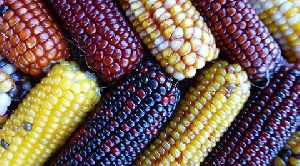Opinions of Tuesday, 26 June 2018
Columnist: Francis Kokutse
Let us watch the poisons we eat!
When there was a recent report of a number of people dying in the Sogakope area, soon after eating “akple”, everyone wanted to blame the corn-miller without looking deep to find out if there were other causes. This is because we have not taken time to understand that the food we eat, especially maize, could be poisonous, because of some contamination.
Sadly, we have taken it for granted that the maize and other farm produce, from the farm-gate to the market are safe for consumption. But this cannot be the case. Unfortunately, governments, over the years, have also not taken the trouble to ensure that our cereals are tested before they are released onto the market.
This has come about because those who should be giving direction on how we keep our food from contamination are either sleeping on the job or, do not know what to do. If this is not the case, then, how come we have allowed mycotoxins to be left out of any serious discussion for a long time. Perhaps, we have taken it for granted that what goes into us will not affect us, but it does.
The scripture may say “it is not what enters into a man’s mouth that defiles him, but it is what comes out of his mouth that defiles him.”—Matthew 15:6-11. The truth however, is that, what we eat daily, either helps us or kills us. That is why it is important that we take a closer look at how what we eat is kept to avoid us from taking poison in the name of food.
The poison we are taking in daily, is the subject matter for a group of African scientists who starting from today till Wednesday, are meeting in Mombasa, Kenya to deliberate on one issue that African governments have not taken seriously. This may be because God has been faithful to us and food contaminated with mycotoxins, have not wiped us off from this world. If the politicians and the policy makers are not aware, our scientists should know of this and so, the million dollar question is why are they not pressuring governments to take action on mycotoxins?
As usual, some Ghanaian scientists from academia or the ministry or agencies connected with food may attend this Mombasa meeting.
After their return, whatever was decided may never come to public attention because those who went there, did not go to listen in order to save lives in Ghana but, because per diem will be paid in dollars. Consequently, more people will die because of the negligence of these people, whom we will never get to know and they will also not own up.
Literature produced for the Mombasa meeting says, mycotoxigenic fungi significantly affect the production, safety and trade of agricultural crops in Africa. However, they said, despite local and international efforts, the continent is plagued by mycotoxigenic fungi that contaminate crops and cause acute and chronic diseases in humans and animals. It is not a new story, this has been known for a while now and why Ghanaian officials and for that matter Africa is treating it lightly, only God can tell.
According to the materials produced by the experts, rural communities are largely unaware of the perpetual poisoning of their daily diets; while producers and traders neither have the ability nor the resources to prevent infection. Africans consume large quantities of maize, wheat, sorghum and groundnuts, and rely on these crops as a primary source of food and income. This is very true because, how can anyone convince my grandmother at Srogbe that the maize from Anloga market is contaminated with mycotoxins when no one has conducted any test. Periodic or regular testing is something we should be doing to keep the public from eating contaminated maize.
Organisers of the conference said, in 2004, acute poisoning of maize with aflatoxins resulted in the deaths of more than 100 Kenyans. Aflatoxins are also associated with liver damage and growth reduction in children in other parts of Africa. Additionally, other mycotoxins like fumonisins, trichothecenes and ochratoxins and their associated fungi; can also be harmful under favourable climatic conditions.
The scientists make a very good case that, to protect consumers and livestock against dangerous mycotoxins, the USA and EU have implemented strict regulations for maximum allowable limits in food and feed. Such regulations are seldom implemented in African countries, and even less regulated, thereby discouraging international trade and impeding economic development on the continent. This is one reason why most of our agricultural produce cannot go on the international market and yet, we have refused to put in place regulations that would ensure that we conduct tests on food before they are sold locally.
Some researchers on mycotoxins say following the discovery of aflatoxins in the early 1960s, there have been many studies leading to the uncovering of many other mycotoxins and the understanding of associated health effects in animals and humans. Consequently, they have pointed out that, there has been a global increase in the number of countries with mycotoxin regulations in foods. However, many African countries have regulations for only aflatoxins (or a few other mycotoxins) in specific foods, or no regulations at all.
In studies that they have conducted, the scientists say, there are challenges thwarting the establishment of mycotoxin regulations and their impacts on human dietary mycotoxin exposure in Africa. They claim that, the occurrence of Fusarium mycotoxins in agricultural products and its processed foods is of great concern because of its toxic effects in humans and animals.
They found that, of all the Fusarium mycotoxins existing, fumonisins are the most studied in Sub-Saharan Africa, (SSA), thus neglecting others and making SSA the part of the world with the least work done with respect to Fusarium mycotoxins research. This is irrespective of climatic change, food insecurity, poor prevention and control strategies, as well as mycotoxin-poisoning problems ravaging this region.
Additionally, they mentioned that most of the studies on Fusarium mycotoxins reported for the region were carried out in laboratories in the developed countries, thus buttressing a lack of infrastructural facilities required to conduct such studies in SSA.
Other issues include the insufficient or lack of adequately trained personnel, as well as limited research investments in terms of funding for SSA research centres and academic institutions. As much as there is a need to reduce hunger within SSA (most especially in the resource poor communities), issues of food safety, as regards Fusarium mycotoxin occurrence in foods and food products should be considered paramount.
The questions that come to mind are; how come we have been able to put in place regulations to test imports and yet we have not deemed it necessary to control what we produce locally? Is it that we so much trust our food producers? But from what our scientists have found out, it is not possible for a maize farmer at Techiman to know if the maize he is selling to traders on his farm is contaminated. That is why we need to put in place measures that will put our food to some form of tests before they come onto the market.
The fact that it has been proven and reported that, so many people have died from mycotoxins in other parts of Africa must wake us up to the knowledge that, the time has come for us to use these lessons to guide what we eat. The government must therefore consider setting up laboratories in the districts to test food from the farm before they get to the market.











